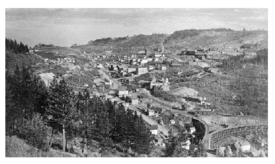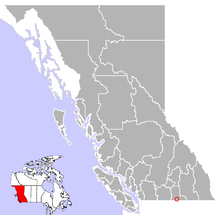Phoenix, British Columbia
| Phoenix | |
|---|---|
| Ghost town | |

Phoenix in 1905
|
|
 Location of Phoenix in British Columbia |
|
| Country |
|
| Province |
|
| Region | Kootenays |
| Regional district | Kootenay Boundary |
| Incorporated | October 1, 1898 |
| Population (2008) | |
| • Total | 0 |
| Time zone | PST (UTC-8) |
Phoenix is a ghost town in the Boundary Country of British Columbia, Canada, 11 km east of Greenwood. Once called the “highest city in Canada” by its citizens (1,412 metres / 4,633 feet above sea level) it was a booming copper mining community from the late 1890s until 1919. In its heyday it was home to 1,000 citizens and had an opera house, twenty hotels, a brewery and its own city hall. Phoenix’s magistrate, Judge Willie Williams, who served there from 1897 until 1913, became famous for his booming declaration, “I am the highest judge, in the highest court, in the highest city in Canada.” In 1911, Phoenix’s hockey team won the provincial championship and asked for the right to compete for the Stanley Cup, but it was too late to qualify. The Granby Consolidated Mining, Smelting and Power Company, Limited operated the Phoenix Mine, a copper mine that produced 13,678,901 tons of ore before operations ceased on June 14, 1919.
Copper was discovered at Phoenix in 1891, credited to American prospector named Bob Denzler. His discovery became the first of many claims and a settlement called Greenwood Camp was built, but it was not until 1895 that the full riches of the area were realized and the boom really began. The log cabins of Greenwood Camp were replaced by frame houses and brick homes. Then, in 1896, the Canadian Pacific Railway and the Great Northern Railway arrived. By then, with the exception of the one at Rossland, the output of the mines was exceeding the combined output of every other copper mine in British Columbia. The town got its own newspaper, the Phoenix Pioneer, in 1896 and on October 1, 1898, Greenwood Camp was renamed Phoenix when the first post office opened. By the early 1900s, Phoenix was a thriving community with electricity and telephone services, a hospital, banquet hall, ballroom, opera house and its own stage line. There was no lack of fine meals or accommodation: on the Christmas Day menu at the Brooklyn Hotel in 1911 the variety of delicacies included Russian caviar, Green Turtle soup and English plum pudding with brandy sauce.
...
Wikipedia
